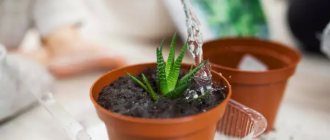Violet is a beautiful and very delicate flower with velvety leaves and beautiful blooms that will decorate the interior of any room.
In order for it to please with its appearance, it needs constant and proper care.
The most important part of care is timely watering . Our material today is dedicated to him.
Requirements for growing conditions
Saintpaulias or indoor violets are often grown, and gardeners wonder how to water violets correctly and what growing conditions are most suitable for plants. Among the features of growing indoor flowers, you need to consider the following:
- Small pots are used for plants. A spacious flower container stimulates the appearance of leaves, but there will be no buds;
- the soil should be light and well breathable. It is also necessary to pay great attention to drainage. In heavy soil, violets will begin to turn yellow and may die;
- air humidity is high. The air around the plants must be humidified using a spray bottle;
- in summer the plant needs a little shade. Direct sunlight can harm delicate leaves.
The plant also needs regular watering and fertilization. It is necessary to water the bush carefully so that drops do not fall on the leaves.
Important! Inexperienced gardeners often make mistakes and spray water on the plant. This can lead to the appearance of diseases on the surface of the leaf.
Light soil
Stores sell special soil for violets. It's very light. But when watering, difficulties arise: the water does not saturate it, but flows along the surface of the soil between it and the walls of the pot.
How to be? My mother has been growing indoor violets for 30 years, and when she just started growing Saintpaulia, there were no special mixtures for sale in stores. And wow, violets grew. And my mother collected soil from the garden, sifted it, added a little sand, and fried it in the oven to kill fungal spores and larvae of pests). And one more thing: at the bottom of the pot there should be a thick layer of drainage (expanded clay) so that the roots can breathe and the water in them does not stagnate.
Proper watering
In order for buds to appear, you need to know how to water violets. The plant prefers warm water that has previously settled. Water must be carefully introduced into the soil under the leaves. After the water has completely saturated the soil, excess liquid from the pan must be removed. Often, excessive moisture leads to rotting of the roots. Therefore, in order to understand how often to water violets at home, it is recommended to take a closer look at the soil. If the top layer of soil is dry, moisture is added. If it is wet, no watering is carried out.
You can also water the plant through a tray. To do this, warm water is poured into the tray and a flower pot is placed. However, using this method, you also need to know how often to water your violets. Watering with this method is carried out no more than once a week. The duration of the procedure is 15-20 minutes, after which excess moisture is removed.
What to do if it's flooded?
Overwatering can cause rotting of the root system . At the same time, they absorb moisture and microelements worse, which can cause the death of the plant. Therefore, it is important to prevent it.
If this does happen, the following method will help:
- And you poured your violets
- The violet is carefully removed from the soil .
- The roots are dried , poorly developed and missing ones are removed. Next, they are wrapped in a paper towel and left there for a day.
- At this time, new soil is being prepared . It is moderately hydrated. After this, you can transplant the flower to a new place.
NeverHappens
Old soil can be used if there is no white coating indicating the formation of mold and fungi. It is better to scald the pot with boiling water to disinfect it. This will reduce the likelihood of transmitting diseases and pests.
What is special about watering?
Watering is a mandatory condition that must be observed when growing plants. It is necessary to water the violets not too much. To prevent moisture from accumulating in the soil, watering is carried out no more than once every 2-3 days.
If moisture appears in the pan, watering stops before the soil dries out a little. Otherwise, diseases may appear.
How to feed the plant for abundant flowering
The question often arises of how often a violet needs to be watered with liquid fertilizers for buds to appear. First of all, it is necessary to understand which element is necessary for plants. If the violet is developing quickly, but there are no buds, this may indicate a large amount of nitrogen. For abundant flowering, the plant must be fed with phosphorus and potassium.
Most often, liquid fertilizers are used, which are mixed with water. How often to water indoor violets with fertilizers depends on the method of applying the substance:
Root method
For abundant flowering, you need to know how many times to water the violet with fertilizer. For frequent watering, you need to add a small amount of fertilizer to the water. For frequent feeding, use 5 parts of the dosage and dissolve in water. The advantage of this fertilizer is the gradual introduction of nutrients, thanks to which the flower actively blooms and grows.
If this method is not suitable, you can feed the plant every 10-15 days. For this purpose, special fertilizers are used. Fertilizer is mixed with water and applied to the root area.
Leaf method
In order to feed indoor violets, the fertilizer is dissolved in warm water and the bush is sprayed with a spray bottle. The frequency of such treatment is no more than once every 2 weeks.
Nutrient components penetrate the leaf plate and saturate the bush with the necessary nutrients.
Small pots
Even the largest domestic violets look like small plants, and even if in some large species the above-ground part (leaves, flowers) is lush and majestic, the root system of all violets still takes up little space in the pot. Therefore, a large pot of Saintpaulia is not needed: in a spacious flowerpot it will grow for a long time and will not bloom soon.
But a container that is too small will not allow the plant to fully develop. So the diameter of the pot for young rosettes and children should be 5-6 cm. An adult flower will need a pot with a diameter of 10-12 cm.
- Physostegia: growing from seeds, types and varieties
In addition, the size of the flowerpot depends on the type of violet. And they are subminiature in size (rosette less than 7 cm), miniature (less than 20 cm) and large (more than 40 cm). Experienced violet lovers use the following rule: the diameter of the pot should be 3 times smaller than the diameter of the flower rosette itself.
How can you water violets?
In order for the plant to bloom, you need not only to know how to properly water violets at home, but also the type of fertilizer to feed.
Homemade products for fertilizing plants
At home, you can use the following products that can be found in almost any kitchen.
- Black tea. To ensure that the soil is not affected by fungi and retains moisture for a long period, it is necessary to mix a small amount of tea with the soil. However, when using such fertilizer, you need to know how often to water the violets. If moistened too often, the tea may clump and interfere with the development of the violet;
- yeast. To stimulate buds, it is necessary to water the bushes with a yeast solution. To do this, you need to prepare 5 liters of warm water and add a tablespoon of dry yeast and 2 tablespoons of sugar. Thoroughly dissolve all ingredients. Leave for several hours to ferment, and carefully feed the indoor violets;
- sugar, the most popular product for feeding. To apply fertilizer, you need to use 1 spoon of sugar per 1 liter and stir the solution thoroughly. Water the soil generously. In order to find out how often it is necessary to water indoor violets with a sugar solution, you need to examine the condition of the bush. For weak bushes, watering is carried out every 15 days. To stimulate flowering, water the bushes once a month.
Properly selected fertilizer can not only stimulate flowering, but also improve the appearance of the bush.
Ready-made drugs
If you don’t have time to prepare fertilizer for feeding, you can use ready-made preparations. The most popular include:
- Uniflor-bud;
- Ambulance;
- Station wagon;
- Ideal;
- Effect.
Each type of fertilizer has detailed recommendations that must be followed.
Useful expert advice for abundant flowering
In order for the violet to bloom profusely, you need to follow some useful tips. These include:
- In order for the violet to bloom regularly, you should not only apply fertilizers, but also create optimal conditions for the growth of the plant;
- Immediately after the bush fades, it is necessary to apply fertilizer. This will contribute to the accumulation of strength and the formation of new buds;
- the plant should be warm;
- Fertilizers must be alternated. Excessive use of organic and mineral nutrients can kill the plant;
- Before watering the soil, you need to loosen it a little. This will stimulate rapid penetration of nutrients to the roots.
In order for Saintpaulias to bloom, after transplanting the bushes must be fed with complex fertilizers.
Water
In order for Saintpaulias to grow beautiful and healthy, it is very important to pay attention to the quality of water.
Advice
It is best to use soft water, pre-settled and filtered. Experienced gardeners also recommend melt water from natural sources - it contains a large number of elements beneficial to plants. However, melted rain or snow water cannot be used.
The liquid for irrigation should be at room temperature; you cannot take water from the tap:
- it may contain calcium salts and chlorine that are harmful to plants;
- At low temperatures, violets will not be able to grow.
Boiled water is not the best option: the beneficial substances it contains are destroyed. Although it is more acceptable than tap liquid. The appearance of a white coating on the soil is a sign that hard water is being used.
How to stimulate violet flowering depending on the time of year
Violet, like any plant, can be in rest mode. During this period, the plant develops poorly and does not form flower stalks.
Winter
In winter, the plant rarely blooms and often forms weak peduncles. During this period, it is recommended to send the plant for wintering. The flower stalks break off and the plant is fed with complex substances.
Summer
In summer, the plant may suffer from elevated temperatures. In order for the indoor violet to produce a peduncle, it is necessary to water every 2 days. Also, the bushes need to be shaded, and phosphorus nutrients must be used as fertilizers.
Spring
The period when it is necessary to transplant the bushes into a new container. Violets bloom profusely, but in order for the buds to be large, it is necessary to water the plants with warm water and add fertilizer.
Autumn
In autumn, violet blooms profusely. However, in order for the bush to regularly set inflorescences, it is necessary to maintain regular watering and apply fertilizer every 15 days.
The abundant flowering of violets allows you to decorate any room. However, in order for the bushes to please with an attractive appearance, you need to know how to water violets at home and what fertilizers should be used. Failure to follow simple recommendations can lead to the death of the flower or a prolonged absence of buds.











